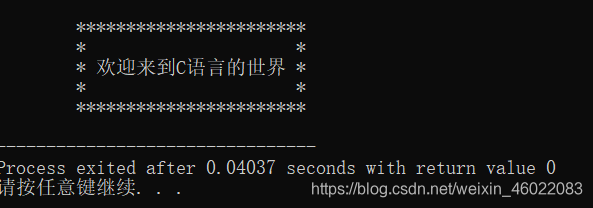目录
- Hello world!程序
- 预处理命令
- 头文件
- 主函数
- 函数返回值
- 注释
- Hello world!加强版
一、最简单的C程序 Hello world!
#include<stdio.h> //编译预处理命令
int main() //定义主函数,主函数类型为整型(int)
{ //函数开始的标志
printf("Hello world!"); //输出内容
return 0; //函数执行完毕时返回一个整数值 0
} //函数结束的标志运行结果:

二、预处理指令(#include<stdio.h>)
1.作用把 stdio.h 头文件的内容读进来
2.其它预处理命令:#define
三、头文件(stdio.h)
stdio.h 文件中具有输入(scanf),输出(printf)等函数的原型声明
- std表示标准:standard
- i 表示输入: input
- o 表示输出:output
- .h 表示头文件 head (文件后缀名)
四、主函数(main)
每一个C语言程序都必须有一个main,且主函数有且仅有1个。
五、函数的返回值(return 0)
主函数main的返回值为 0 时表示程序正常退出
返回值为非零时,表示程序异常退出
六、注释
C语言允许两种注释
第一种:以 // 开始的单行注释
第二种:以 /* 开始,以 */ 结束的多行注释(块式注释)
七、Hello world!加强版
加强版 1………………
#include<stdio.h>
int main()
{
printf("\tHello world!\n"); // \n 换行符 \t 横向空格
return 0;
}执行结果:

加强版 2………………
#include<stdio.h>
int main()
{
printf("\n\tHello\n\nworld!\n"); // \n 换行符 \t 横向空格
return 0;
}执行结果:

加强版3……………欢迎来到C语言的世界
扫描二维码关注公众号,回复:
11107610 查看本文章


#include<stdio.h>
int main()
{
printf("\n\t***********************\n");
printf("\t* *\n");
printf("\t* 欢迎来到C语言的世界 *\n");
printf("\t* *\n");
printf("\t***********************\n");
return 0;
}执行结果:

通过 \n 换行符,\t 横向空格等等一些转义字符的结合和设计,可以让你写的程序,输出内容更加美观和有吸引力。
…………………………
以上是我经过一段时间对C语言的学习,总结出来的最简单的C程序中各种内容的功能以及加强版Hello world!
如果以上内容有什么错误的地方,请大家指正(共同进步)
这是我第写的第一个C程序,不知道你是不是!!!
那时候,在写这个程序的时候,在电脑上慢慢腾腾,反复修改,最后当在屏幕上输出 Hello world! 时心里猛然感叹道:从此算是走上了程序猿这条 “不归路” ……

